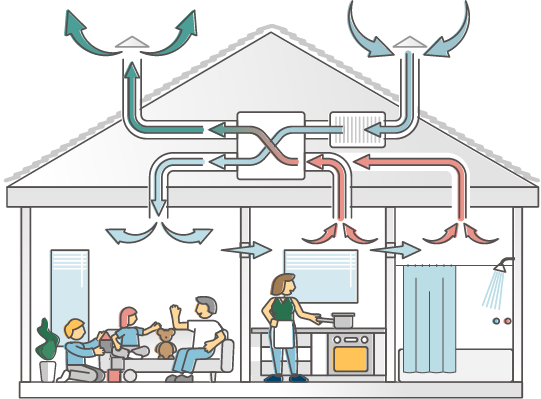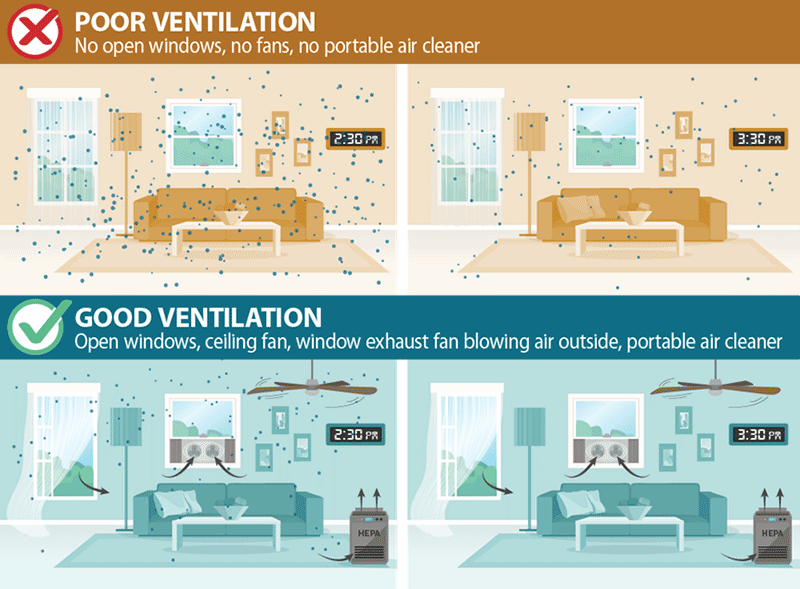Home Ventilation Melbourne: Best Practices for Year-Round Air Quality
Checking Out Cutting-edge Solutions for Optimal Home Ventilation Solutions
Home air flow plays a necessary role in preserving wellness and comfort within living areas. With developments in modern technology, innovative options are emerging to enhance these systems. Smart air flow, power recovery ventilators, and progressed filtration are reshaping exactly how air high quality is taken care of - Home Ventilation Melbourne. However, the combination of these modern technologies questions regarding their efficiency and flexibility in diverse home environments. What implications do these growths hold for future living standards?
The Importance of Home Ventilation for Health and Comfort
Commonly ignored, home air flow plays an essential role in maintaining both wellness and convenience within property spaces. Sufficient air flow is essential for the blood circulation of fresh air, which aids to weaken indoor pollutants such as volatile natural substances, irritants, and odors. Without proper air movement, these impurities can collect, causing breathing issues and other wellness issues. Furthermore, reliable ventilation contributes to managing moisture levels, avoiding mold and mildew growth and structural damages. By making sure a balanced exchange of air, locals can delight in an extra pleasurable indoor setting, enhancing total wellness. Ample ventilation can improve energy performance by decreasing the demand for excessive heating or cooling, eventually resulting in reduced energy costs and a more lasting living room.
Smart Ventilation Systems: Harnessing Innovation for Effectiveness
Smart air flow systems stand for a significant innovation in home air monitoring, leveraging IoT integration for enhanced control. These systems not only promote energy efficiency however also provide remote tracking abilities, permitting customers to maximize their interior environments seamlessly. By harnessing technology, house owners can accomplish enhanced air high quality while minimizing power usage.
IoT Integration Benefits
How can IoT integration change typical air flow systems right into very reliable clever remedies? By including Net of Points (IoT) modern technology, air flow systems can accomplish real-time tracking and control, enhancing their operational performance. Sensing units put throughout a home gather data on air temperature, high quality, and humidity, enabling automated adjustments based upon present conditions. This prompt responsiveness causes enhanced indoor air top quality and convenience levels. Additionally, IoT-enabled systems can interact with various other wise home devices, developing a natural ecosystem that enhances energy usage. Users can additionally gain access to and handle their ventilation systems remotely via smart devices, offering ease and enhanced control. On the whole, IoT combination stands for a substantial improvement, bringing intelligence and versatility to typical ventilation techniques.
Energy Effectiveness Includes
As energy performance becomes an essential focus in contemporary home layout, advanced ventilation systems supply ingenious attributes that significantly lower power consumption. These wise air flow systems use sensing units to keep track of interior air moisture, top quality, and temperature levels, immediately changing air flow to keep perfect conditions. By utilizing power recovery ventilators (ERVs), they recycle and catch power from outward bound air, decreasing home heating and cooling demands. Variable speed fans additionally improve performance by adjusting their operation based on real-time needs, preventing unnecessary energy waste - Home Ventilation Melbourne. In addition, programmable timers and occupancy sensors ensure that air flow runs only when required, contributing to lower utility bills. Jointly, these features represent a considerable improvement in producing sustainable and energy-efficient living environments
Remote Surveillance Capacities
What benefits do remote monitoring capacities offer contemporary home ventilation systems? These capabilities allow house owners to track indoor air high quality and system performance in real time, enhancing total effectiveness. By offering data on temperature level, air, and humidity pollutants, wise ventilation systems enable aggressive adjustments, ensuring ideal conditions. Additionally, remote surveillance facilitates maintenance informs, determining possible issues before they rise, consequently minimizing fixing costs and downtime. Customers can access system analytics with mobile applications, permitting practical control also when away from home. This technical integration not just promotes power efficiency but additionally adds to a much healthier living environment. Eventually, remote surveillance abilities stand for a considerable improvement in home ventilation, lining up with the expanding demand for clever home technologies.
Energy Recuperation Ventilators: Maximizing Energy Financial Savings
Energy healing ventilators (ERVs) play an important function in enhancing home energy performance through efficient warmth exchange. By transferring thermal energy between outbound and inbound air, these systems markedly lower general energy intake. This innovative method not just keeps interior air quality but also contributes to reduce energy expenses.
Performance of Warmth Exchange
While preserving interior air top quality is important for health and wellness and convenience, the performance of warmth exchange in power recovery ventilators (ERVs) plays an important role in maximizing energy savings. The primary function of an ERV is to move heat and wetness between incoming and outbound air streams, which optimizes indoor conditions while lessening energy loss. High-efficiency warm exchangers can significantly minimize the tons on heating and cooling systems by reclaiming power that would or else be thrown away. The performance of these systems is often gauged by their core temperature level exchange prices, which can differ based upon style and materials used. By concentrating on innovative warm exchange innovations, property owners can enhance their air flow systems, leading to boosted power effectiveness and cost decreases gradually.
Minimized Energy Intake
Minimizing power usage is a key benefit of power recuperation ventilators (ERVs), as they effectively recycle thermal power from exhausted air. By moving heat in between outbound and inbound air streams, ERVs minimize the requirement for additional home heating or cooling, bring about substantial power cost savings. This procedure not only lowers utility prices however additionally reduces the ecological effect connected with higher power use. Furthermore, ERVs preserve consistent indoor air quality without endangering thermal comfort, developing a balanced living setting. By integrating ERVs into home air flow systems, home owners can accomplish better energy performance, enabling a lasting strategy to indoor air monitoring while benefiting from lower power bills. Eventually, ERVs stand for a compelling remedy for energy-conscious consumers.
Advanced Filtering Technologies for Cleanser Indoor Air
As indoor air high quality comes to be increasingly acknowledged as a vital part of health and wellness, progressed filtration technologies are becoming essential tools for guaranteeing cleaner settings. These modern technologies include high-efficiency particulate air (HEPA) filters, activated carbon filters, and electrostatic precipitators, each developed to efficiently catch air-borne toxins, irritants, and volatile organic compounds (VOCs) HEPA filters can catch fragments as small as 0.3 microns, greatly decreasing allergens like allergen and family pet dander. Triggered carbon filters master adsorbing smells and chemical vapors, adding to a fresher indoor environment. Furthermore, electrostatic precipitators use electrical charges to remove particles, providing an energy-efficient choice. By incorporating these innovative purification systems, home owners can boost interior air high quality and promote healthier space.
The Duty of Sensing Units in Enhancing Air Flow and High Quality
How can sensors change the monitoring of indoor air high quality? Sensors play an important role in improving air movement and boosting indoor environments. By continually checking aspects such as humidity, temperature, and degrees of contaminants, they supply real-time data that informs air flow systems. This info allows computerized modifications to airflow, making sure appropriate flow and reducing the build-up of pollutants. Additionally, progressed sensors can identify details air quality concerns, triggering prompt actions to enhance comfort and wellness. The combination of these gadgets into ventilation systems permits for a much more receptive and efficient administration strategy, minimizing energy usage while keeping optimal air top quality. Ultimately, sensing units offer as a vital element in developing healthier indoor areas via accurate air flow regulation.
Integrating Ventilation With Smart Home Systems
While numerous home owners look for benefit and effectiveness, incorporating air flow systems with smart home innovation offers an ingenious remedy to managing indoor air high quality. By linking air flow devices to clever home hubs, locals can automate air top quality Going Here monitoring and control airflow based on real-time data. These systems can reply to adjustments in temperature, humidity, and contaminant degrees, ensuring suitable interior problems. Smart thermostats can work in tandem with ventilation systems to boost energy efficiency, reducing costs while maintaining comfort. Property owners can also remotely regulate their air flow setups with mobile apps, offering flexibility and satisfaction. Ultimately, this integration not only streamlines monitoring however considerably boosts the total living setting, making it a beneficial enhancement to modern-day homes.
Future Fads in Home Air Flow Solutions
Emerging technologies and enhanced understanding of indoor air quality are forming the future of home air flow options. One significant fad is the combination of expert system, making it possible for systems to change airflow based upon real-time information and tenancy patterns. On top of that, power healing ventilators are gaining grip, offering efficient air exchange while decreasing power loss. Using eco-friendly materials and styles is also on the rise, aligning with sustainability objectives. Smart sensors that check contaminants and humidity levels are becoming requirement, permitting property owners to maintain optimal interior environments. Modular and scalable systems are arising, giving personalized options for various home sizes and setups. With each other, these innovations guarantee to enhance comfort, efficiency, and wellness in property spaces
Regularly Asked Concerns
How Often Should I Clean My Home Air Flow System?

The regularity of cleansing a home air flow system varies based upon usage and setting. Typically, it is recommended to clean the system every 3 to 6 months to preserve perfect air quality and system effectiveness.
Can Poor Ventilation Cause Mold Development Inside Your Home?

What Are the Indications of Inadequate Home Air Flow?
Signs of inadequate home ventilation include relentless smells, boosted humidity degrees, condensation on official source home windows, visible mold and mildew growth, and a general sensation of stodginess. These indicators frequently suggest that air circulation wants for maintaining a healthy and balanced indoor environment.
Just How Can I Boost Ventilation in Older Houses?
To improve ventilation in older homes, blog one might consider setting up exhaust fans, making use of natural air flow with windows, sealing spaces for better air control, and including air purifiers to boost indoor air quality effectively.
Are DIY Ventilation Solutions Effective and Safe?

Smart air flow, power recovery ventilators, and progressed purification are reshaping exactly how air top quality is handled. As power efficiency becomes a critical emphasis in modern-day home design, advanced ventilation systems offer ingenious attributes that significantly reduce energy consumption. By integrating ERVs right into home air flow systems, house owners can attain higher power performance, enabling a lasting method to indoor air administration while benefiting from reduced power expenses. The assimilation of these tools into air flow systems permits for a much more effective and receptive management method, minimizing power consumption while preserving optimal air top quality. While several property owners seek comfort and performance, integrating ventilation systems with wise home innovation provides an ingenious remedy to taking care of interior air top quality.